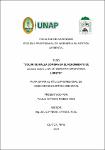| dc.contributor.advisor | Pinedo Jiménez, Julio | |
| dc.contributor.author | Pinedo Rios, Paulo Antonio | |
| dc.date.accessioned | 2022-09-06T18:48:41Z | |
| dc.date.available | 2022-09-06T18:48:41Z | |
| dc.date.issued | 2022 | |
| dc.identifier.uri | https://hdl.handle.net/20.500.12737/8291 | |
| dc.description.abstract | Lettuce is one of the most consumed olive species in the diet, its cultivation is generally carried out in a conventional system, protection horticulture such as hydroponics allows to improve its vegetative adaptation and yield, the main objective was to determine the effect of shadow mesh color with 35% fabric. The completely randomized design was used with the treatments: red mesh (T1) and aluminet mesh (T2). The nursery was made on a moistened sheet of paper towel, then after 5 days each seedling was placed in a sponge cube accommodated in a Technopor float fed in a source of nutrient solution, after 10 days they were transplanted to the 3” PVC tubes distributed at 1.0 m above the ground, each tube was fed with a circular flow sheet of nutrients, until harvest at 35 days. To evaluate the effect of shaded mesh color, the meshes were extended to a height of 2.50 m from the level of the culture tube platform. With the red mesh in relation to the aluminet mesh, a higher average plant weight in g (p<0.01) was obtained with 66.03 and 43.53, plant width in cm (p>0.1) with 25.37 and 24.7 and also the number of leaves per plant (p<0.01) with means of 11.23 and 8.90. The results of the cultivation of lettuce under shade mesh (35%) show that under red shade compared to the aluminized mesh, a greater number of leaves and greater plant weight were achieved in the technique of laminar flow of nutrients in a hydroponic system in the Loreto region. | en_US |
| dc.description.abstract | La lechuga es una de las especies olerícolas de mayor consumo en la dieta alimenticia, generalmente su cultivo se realiza en un sistema convencional, la horticultura de protección como la hidroponía permite mejorar su adaptación vegetativa y el rendimiento; el objetivo principal fue determinar el efecto de color de malla sombra con 35% de tejido. Se empleó el diseño completamente al azar con los tratamientos: Malla roja (T1) y Malla aluminet (T2). Se realizó el almácigo en una lámina humedecida en papel toalla, luego a los 5 días a cada plántula se le colocó en un cubo de esponja acomodada en un flotador de tecnopor alimentada en una fuente de solución nutritiva, a los 10 días se trasplantaron a los tubos de PVC de 3” distribuidos a 1.0 m de altura del suelo, cada tubo fue alimentada con una lámina de flujo circular de nutrientes, hasta el momento de la cosecha a los 35 días. Para evaluar el efecto del color de malla sombra, las mallas se extendieron a una altura de 2.50 m del nivel de la plataforma de tubos de cultivo. Con la malla color roja en relación a la malla aluminet se obtuvo mayor peso promedio de planta en g (p<0.01) con 66.03 y 43.53, ancho de planta en cm (p>0.1) con 25.37 y 24.7 y también cantidad de hojas por planta (p<0.01) con promedios de 11.23 y 8.90. Los resultados del cultivo de lechuga bajo malla sombra (35%) muestran que bajo sombra de color roja respecto a la malla aluminizada se logró mayor cantidad de hojas y mayor peso de planta en la técnica del flujo laminar de nutrientes en un sistema hidropónico en la región Loreto. | es_PE |
| dc.format | application/pdf | es_PE |
| dc.language.iso | spa | es_PE |
| dc.publisher | Universidad Nacional de la Amazonía Peruana | es_PE |
| dc.rights | info:eu-repo/semantics/openAccess | * |
| dc.rights.uri | https://creativecommons.org/licenses/by/4.0/ | * |
| dc.subject | Propagación vegetativa | es_PE |
| dc.subject | Lactuca sativa | es_PE |
| dc.subject | Protección de las plantas | es_PE |
| dc.subject | Color | es_PE |
| dc.title | Color de malla sombra en el rendimiento de Lactuca sativa L. en un sistema hidropónico. Loreto | es_PE |
| dc.type | info:eu-repo/semantics/bachelorThesis | es_PE |
| thesis.degree.discipline | Ingeniería en Gestión Ambiental | es_PE |
| thesis.degree.grantor | Universidad Nacional de la Amazonía Peruana. Facultad de Agronomía | es_PE |
| thesis.degree.name | Ingeniero(a) en Gestión Ambiental | es_PE |
| dc.subject.ocde | https://purl.org/pe-repo/ocde/ford#4.01.06 | es_PE |
| renati.author.dni | 72362376 | |
| renati.advisor.orcid | https://orcid.org/0000-0001-6784-0803 | |
| renati.advisor.dni | 05248692 | |
| renati.type | https://purl.org/pe-repo/renati/type#tesis | es_PE |
| renati.discipline | 521236 | es_PE |
| renati.level | https://purl.org/pe-repo/renati/level#tituloProfesional | es_PE |
| renati.juror | Bohabot Gomez, Elizabeth | |
| renati.juror | Cubas Encinas, Omar | |
| renati.juror | Avila Fucos, Manuel Calixto | |
| dc.publisher.country | PE | es_PE |


